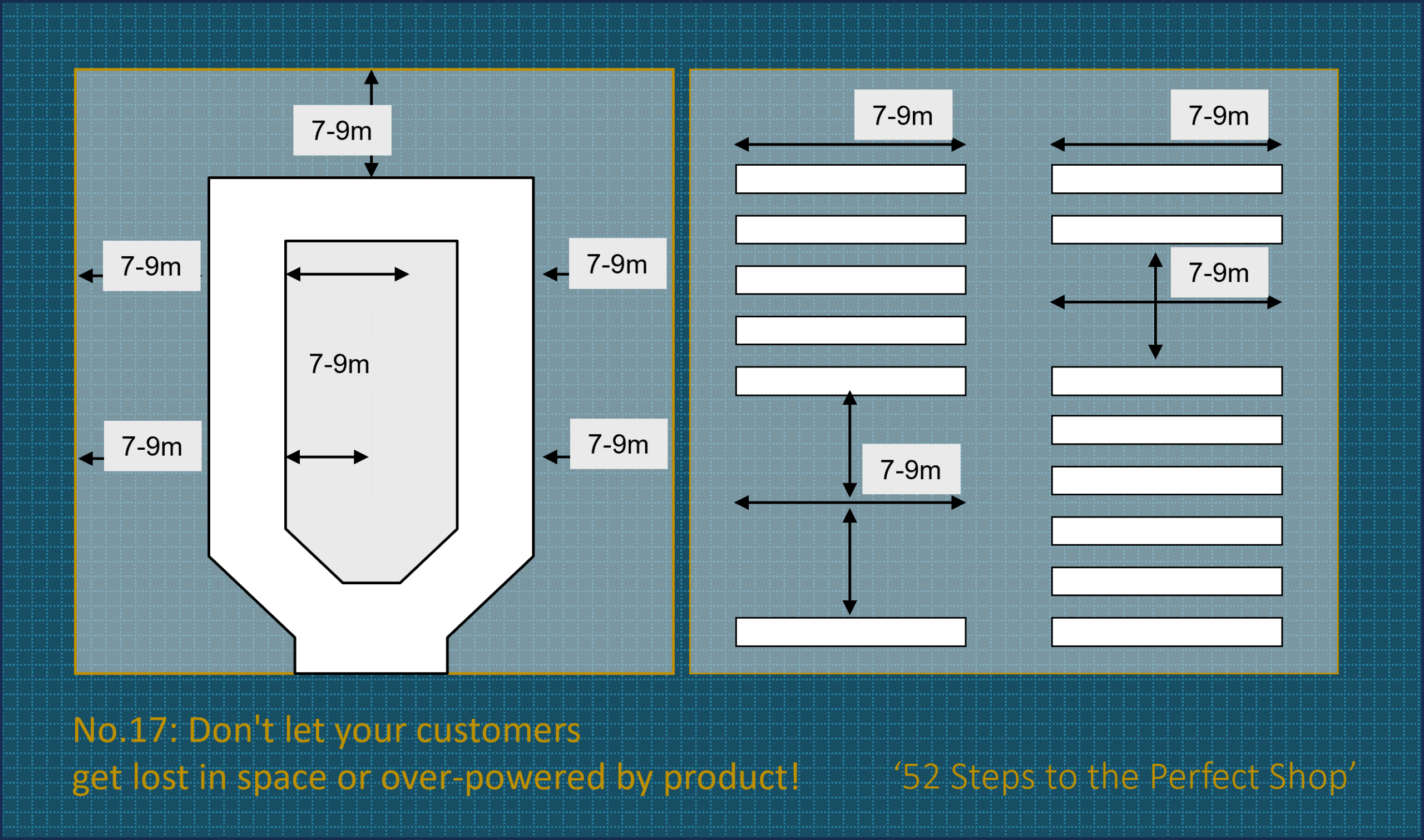Post No.16 in the weekly newsletter series:
‘52 Steps to the Perfect Shop!’
You too can have ‘The Perfect Shop’ by this time next year!
We have introduced the 3 fundamental types of shop layout, the grid, race-track and free-flow, and explained why it is important to select the most appropriate for your product proposition and the way your customer buys.
We have stated that there is only one best layout for each shop, and that this is based on its size & dimensions.
What we now need to understand is the importance of using layouts and walkways to make the customer feel secure & happy in your shop spaces, and how to achieve this.
We need to avoid the customer feeling ‘lost in space!’ And we need to avoid the customer being ‘over-powered by product!’ The key to this, and to your layout, is to control the distance between the customer and the product.
Much research has gone into customer shopping psychology and behaviour. Being either ‘lost in space’ or ‘over-powered by product’ are big turn-offs for customers. They will stop customers buying and stop customers visiting. This is why shop layouts and walkway placements are so critical.
For customers in an average sized shop – lets say 200sqm, they feel most comfortable navigating the store when their first experience of product is around 5 metres away. Of course as they shop they look at, and touch products much closer, but for shop orientation and navigation a distance of around 5 metres is perfect, from the walkway to product walls, to segment the space .
The 5 metre ideal varies by shop size. In a large shop of several 100s and even 1000s of square metres the space must be segmented and the distance between all walkways and product walls must be controlled so it is never more than 10 metres.
If a customer on a walkways has to look further than those 10 metres to see a product wall they will feel ‘lost in space.’ Customers generally will not enter into this space without those strong visual product messages to guide them and attract them.
Some traditional shop layout thinking recommends that customers should be always able to see as far as possible, even in large shops. But this doesn’t work for customers. They in fact ‘see everything, but they see nothing!’ Nothing attracts them. They often turn and leave.
Large shops need to build new internal and temporary walls to segment space to always create walkway journeys through the space that continually attract and guide customers.
Consider IKEA who transform very large spaces into a carefully constructed walkways with controlled walkway to product wall distances. Not only does this make the customer happy to take the journey but its also means that incredibly 90% of IKEAs products are visible to a customer!
For smaller shops the risk of unsettling customers is to over-power them with products which are too close and too much ‘in-their face.’ Ensure that walkway to product wall distances are no smaller that 2 metres each side, absolute minimum, to avoid creating customer tunnels.
Ultimately shopping spaces are created by different fixture types. The best strategy is to have low fixtures next to the walkways, mid-height floor fixtures and high wall fixtures at the optimum distance. This creates perfect space segments for navigating and browsing.
And in smaller shops in particular, the optimum distance for space segmentation is also influenced by the type of product, size of packaging, the need to browse or seek, the shop design elements, lighting, ceiling heights. So much so that benchmarking similar sized shops of best practice and testing your own as customers would, are so important to defining the best walkways and space segment distances for each shop.
So take as much time as you need to ensure that you get your shop layout correct. Measure the distance between your customer and the product. Test your layout. Observe customer behaviour. Get feedback. Analyse sales. Do it once and get it right!
Make the customer relaxed. Avoid them getting ‘lost in space’ and ‘overpowered by product!’
Then you can enjoy yourself displaying and presenting your wonderful products to the customer in the safe knowledge that your time and creativity will not be wasted. Your work will always be in full and glorious view.
For everyone looking to improve their physical shops, or thinking of opening their first pop-up or permanent shop.
The weekly newsletters, and the 10 content modules they feature, have been created from my experiences of opening hundreds of shops, of all different sizes, situated across the world, selling just about everything there is to sell.
Every week we explore the sequential process of physical shop development to help you deliver your perfect shop.
Missed any of the previous ’52 Steps’ then just click here to catch up…
